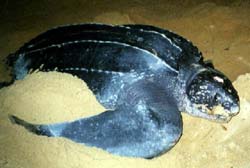Pacific leatherback turtle could go extinct in 10 years

Leatherback turtle nesting in French Guiana <br>Credit: Seaturtle.org ® Matthew Godfrey
Scientists at international conference release strategy to save them
The leatherback turtle, a gentle giant weighing close to a ton (907 kg) and measuring eight feet (2.4 meters) in length, may be extinct within a decade in the Pacific Ocean.
The news was released at the 24th Annual Symposium on Sea Turtle Conservation and Biology, a weeklong conference in San Jose, Costa Rica attended by more than 1,000 experts from 70 countries.
Named for its smooth, leathery skin, the leatherback has graced ocean waters from the tropics to the Arctic since the time of the dinosaurs more than 100 million years ago. But scientists have documented a precipitous decline of the Pacific leatherback in the past two decades. Since 1982, their numbers have dropped from approximately 115,000 reproductive females to fewer than 3,000 remaining today, a decline of 97 percent.
“On land, the canary in the coal mine warns humans of impending environmental danger,” said Roderic Mast, Conservation International Vice President and President of the International Sea Turtle Society. “Sea turtles act as our warning mechanism for the health of the ocean, and what they’re telling us is quite alarming. Their plummeting numbers are, unfortunately, symptomatic of the ocean as a whole.”
Although the leatherback may be the world’s best-known sea turtle, five of the other six sea turtle species are also at risk of extinction. The Kemp’s ridley and hawksbill turtles are classified by the IUCN Red List as Critically Endangered, as is the leatherback. The green, olive ridley and loggerhead turtles are all considered Endangered. The flatback turtle, found solely on the northern coast of Australia, is regarded as Data Deficient.
Sea turtles face threats ranging from destructive fishing practices such as long-lining and the poaching of turtle eggs, which some cultures regard as a delicacy. Long-lining is a practice in which ships extend up to 90 miles of fishing line with as many as 8,000 hooks, many of which unintentionally capture and kill sea turtles instead of their intended targets of fish.
“The Pacific leatherbacks currently face an annual mortality rate of up to 30 percent,” said James R. Spotila, Drexel University Professor of Environmental Science. “That rate is clearly unsustainable, and without dramatic intervention, we can expect to see them disappear in as soon as a decade.”
Scientists say that a two-pronged approach is necessary in order to reverse the rapid population decline of sea turtles:
Nesting beaches require stronger protections and more careful management. Uncontrolled beachfront development and the poaching of eggs are threats to their survival. Lights on land present another threat, since turtles confuse them for the moon and walk toward them, leaving them stranded and unable to return to the ocean. Stronger protections to beaches in St. Croix and South Africa, for example, have allowed leatherback populations to begin rebounding.
The ocean needs greater levels of protection and the fishing industry needs to employ new and safer techniques. Currently, less than one-half of one percent of the ocean enjoys formal protection. Fishermen targeting fish species often unintentionally kill sea turtles as “by-catch.” Small and inexpensive changes to fishing techniques, such as slightly larger hooks and traps from which sea turtles can escape, can dramatically cut the mortality rate.
Scientists and conservationists at the conference highlighted several international success stories that demonstrate that well-planned conservation efforts can halt and reverse the decline of the sea turtles.
For example, four Latin American nations, the United Nations Foundation, UNESCO’s World Heritage Centre and Conservation International’s Global Conservation Fund are investing several million dollars over the next three years to consolidate a marine protected area that stretches from Ecuador to Costa Rica.
The 24th Annual Symposium on Sea Turtle Conservation and Biology is focusing on the relationship between humans and sea turtles this year. Once only a forum for an exchange of ideas, the symposium today has evolved into one of the most important and influential decision-making bodies for the conservation of sea turtles worldwide.
Conservation International (CI) applies innovations in science, economics, policy and community participation to protect the Earth’s richest regions of plant and animal diversity in the hotspots, major tropical wilderness areas and key marine ecosystems. With headquarters in Washington, D.C., CI works in more than 40 countries on four continents. For more information about CI, visit www.conservation.org.
Media Contact
More Information:
http://www.conservation.org/All latest news from the category: Ecology, The Environment and Conservation
This complex theme deals primarily with interactions between organisms and the environmental factors that impact them, but to a greater extent between individual inanimate environmental factors.
innovations-report offers informative reports and articles on topics such as climate protection, landscape conservation, ecological systems, wildlife and nature parks and ecosystem efficiency and balance.
Newest articles

First-of-its-kind study uses remote sensing to monitor plastic debris in rivers and lakes
Remote sensing creates a cost-effective solution to monitoring plastic pollution. A first-of-its-kind study from researchers at the University of Minnesota Twin Cities shows how remote sensing can help monitor and…

Laser-based artificial neuron mimics nerve cell functions at lightning speed
With a processing speed a billion times faster than nature, chip-based laser neuron could help advance AI tasks such as pattern recognition and sequence prediction. Researchers have developed a laser-based…

Optimising the processing of plastic waste
Just one look in the yellow bin reveals a colourful jumble of different types of plastic. However, the purer and more uniform plastic waste is, the easier it is to…



